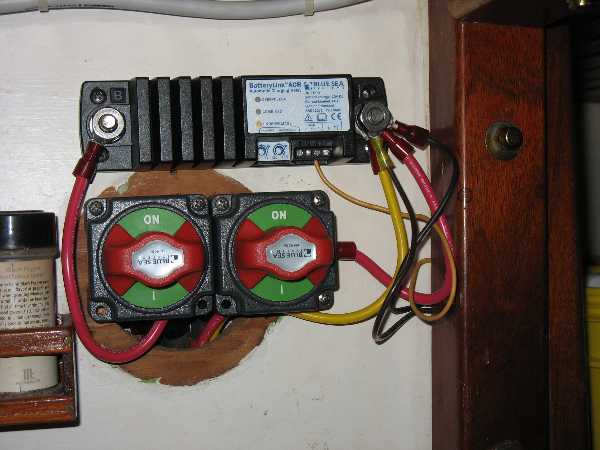Battery combiner
The next learning experience came with the 2004 Great River Race. This is an overnight race in early October on Lake Guntersville between Lower Guntersville Light to Seyboldt light. I took the short course which is two laps or about 32 nautical miles. I crossed the starting line about 1030 Saturday and did not finish until about 0400 Sunday. The battery ran flat about 0100 Sunday after powering energy hungry cabin and running lights. I sailed on down the river completely darkened, hoping that the marine police did not show up to give me a ticket for lack of running lights. After finishing the race I got a tow to the marina. The towing boat was a San Juan 19 which could not tow me into the marina. The wind caught Andrea Lynn and pulled me past the entrance inspite of what JL could do aboard the San Juan 19. I let go and dropped anchor. I was smoking out the ears and the mouth. I worked out a deal with the Vice Commodore where I could borrow a fully charged battery in return for being Cruise Chairman for the sailing club in 2005. I then put the battery in, pulled up anchor and zipped back into the dock.
The problems I had represent a serious operational shortcoming. Before I did another Great River Race something had to be done.
I then read about battery combiners in the West Marine Catalog. I find their advisor sidebars to be consistent with my experiences. They are informative and on target. Also, I have found Blue Sea Systems products to be rugged and dependable. So I bought their battery combiner. I set up a starting battery for the engine. I then set up a house battery for everything else. I installed an on/off switch for each one that completely isolates the battery in case there is going to be a problem. I followed the instructions and met all the requirements for its installation.
Basically, a battery combiner is an automatic relay that works by sensing alternator output. When the engine is started the alternator starts generating voltage. The relay senses it and connects both batteries so they receive a charge. When the engine is shut down it senses a lack of alternator output voltage. It waits one minute and then cuts off the connection so that the batteries are isolated from each other. The advantages are that I can play the stereo all night and not worry about whether I can start the motor the next day. When I get ready to take the boat out I turn these two switches to the on position. I don't touch them again until I have returned to the dock and have secured the boat for the week.

Here is the installed Battery Link ACR and master switches. The left switch is the starter battery. The right switch is the house battery. The large yellow wire is the charging wire. The large red wires go to the positive terminals of the batteries. The small yellow wire is for the voltage sensing ground.